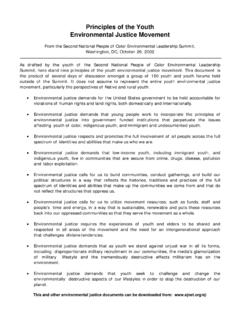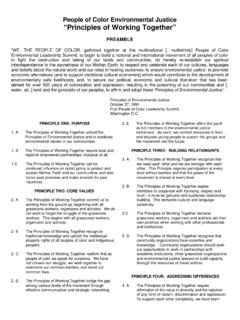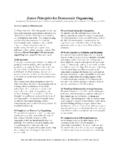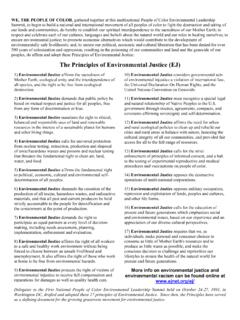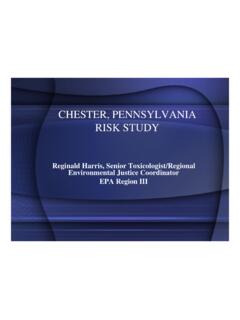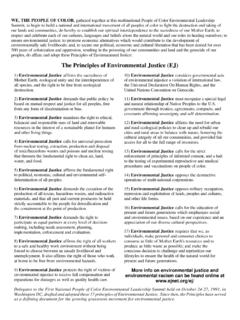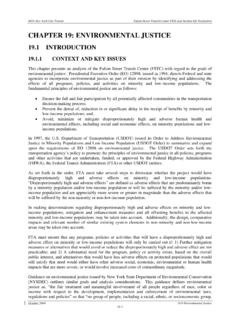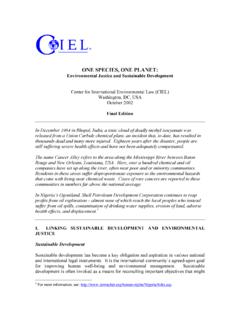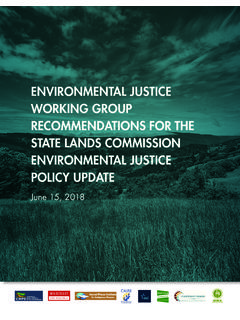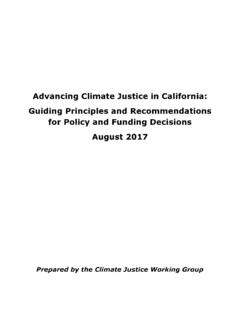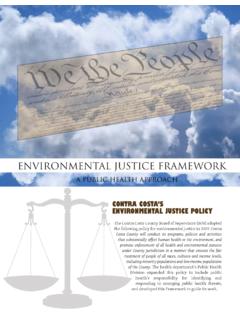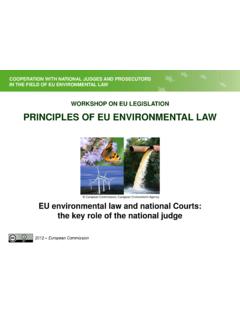Transcription of Legal Tools for Environmental Equity vs. Environmental Justice
1 1 Legal Tools for Environmental Equity vs. Environmental Justice October 15, 2012 Mike Ewall, Esq. Founder & Director Energy Justice Network In 1982, when Benjamin Chavis coined the term Environmental racism to describe the targeting of a black community in Warren County, North Carolina for a toxic waste dump, it brought together two powerful movements the civil rights and Environmental movements into a growing force that would eventually reach the White House and the United States Supreme Court. No one would have guessed at the time that within a 5-day span around Earth Day 2001, the Legal side of the movement against Environmental racism would see its brightest, and then darkest, days.
2 Since the early 1980s, numerous studies have looked at the correlation between Environmental hazards and the race and class demographics of the communities where these hazards are The vast majority have shown a trend toward low-income 1 The following is a chronological list of some of the major studies demonstrating the Environmental racism trend. Some of these, and additional studies, can be found at Most are cited as described in Bradford C. Mank, Environmental Justice and Title VI: Making Recipient Agencies Justify Their Siting Decisions, 73 Tul.
3 L. Rev. 787 , 1999. General Accounting Office, GAO/RCED-83-168, Siting of Hazardous Waste Landfills and Their Correlation with Racial and Economic Status of Surrounding Communities, 1983. (examining racial and socioeconomic characteristics of the communities surrounding four offsite hazardous waste landfills located in the eight southeastern states that make up the EPA's region IV and finding that blacks make up the majority of the population in three of the four communities where the landfills are located ) Robert D. Bullard, Solid Waste and the Black Houston Community, 53 Soc.
4 Inquiry 273, 279-83, 1983. (finding that although African-Americans made up only 28% of the Houston population in 1980, 6 of Houston's 8 incinerators and mini-incinerators and 15 of 17 landfills were located in predominantly African-American neighborhoods) Commission for Racial Justice , United Church of Christ, Toxic Wastes and Race in the United States, 1987. (involving the location of all 415 commercial hazardous waste facilities in the contiguous United States that could be identified through the EPA's Hazardous Waste Data Management System, using zip code areas to define minority and nonminority areas, and concluding that although socio-economic status appeared to play an important role in the location of commercial hazardous waste facilities, race still proved to be more significant ) Benjamin A.
5 Goldman & Laura Fitton, Toxic Wastes and Race Revisited: An Update of the 1987 Report on the Racial and Socioeconomic Characteristics of Communities with Hazardous Waste Sites, 1994. (relying on zip code areas to find that the 2communities and especially communities of color being unfairly burdened with excessive pollution from a variety of polluting industries and chemical exposures. These studies affirmed the understanding of an Environmental racism trend. While many are quick to conclude that communities of color are targeted solely because of their generally low-income socio-economic status, most of the studies have demonstrated that race is more of a factor than class.)
6 In other words, if one were to compare a middle-class community of color to a low-income white community, and look at which community is more likely to have a hazardous waste facility sited there, the middle-class community of color would have a greater chance of being targeted for such a facility. In fact, in some cases, race is a more significant indicator of pollution burdens than income, poverty, childhood poverty, education, job classification or home Demographic studies showing disparate distribution of polluting industrial facilities have been key aspects of many Environmental racism lawsuits.
7 Such studies of location of hazardous waste facilities reflects a national pattern of racial inequality that has gotten worse during the past decade; concentrations of racial minorities living in close proximity to toxic waste sites had increased) Bradford C. Mank, Environmental Justice and Discriminatory Siting: Risk-Based Representation and Equitable Compensation, 56 Ohio St. 329, 334-41, 1995. (summarizing studies finding that racial minorities and low-income persons live near pollution to a disproportionate extent) Vicki Been & Francis Gupta, Coming to the Nuisance or Going to the Barrios?
8 A Longitudinal Analysis of Environmental Justice Claims, 24 Ecology 1, 9, 19-27, 33-34, 1997. (examining 544 communities, using 1990 census data, that hosted active commercial hazardous waste treatment storage and disposal facilities and finding no substantial evidence that commercial hazardous waste facilities that began operating between 1970 and 1990 were sited in areas that had disproportionate African-American or low-income populations, but finding evidence that Hispanics were disproportionately more likely to live near such facilities) J. Tom Boer et al., Is There Environmental Racism?
9 The Demographics of Hazardous Waste in Los Angeles County, 78 Soc. Sci. Q. 793, 1997. (finding that working class communities of color in industrial areas of Los Angeles are most affected by hazardous waste treatment storage and disposal facilities) Evan J. Ringquist, Equity and the Distribution of Environmental Risk: The Case of TRI Facilities, 78 Soc. Sci. Q. 811, 1997. (finding that Toxic Release Inventory facilities and pollutants are concentrated in residential zip codes with large minority populations) Rachel Morello-Frosch et al., Environmental Justice and Southern California's Riskscape: The Distribution of Air Toxics Exposures and Health Risks Among Diverse Communities, 36 Urb.
10 Aff. Rev. 551, 552, 562, 2001. (study of the Southern California Air Basin finding that people of color had a consistently higher cancer risk due to air toxics than did whites, with Latinos having the highest risk) Robert D. Bullard, Paul Mohai, Robin Saha, and Beverly Wright, Toxic Wastes and Race at Twenty: Why Race Still Matters After All These Years, 38 Environmental Law Review 371, 2008. (revising the 1987 Toxic Wastes and Race study of hazardous waste facilities using newer mapping technology, and finding that the trend is still as bad or worse than it was in 1987) 2 Environmental Justice report on Delaware County, Pennsylvania.
